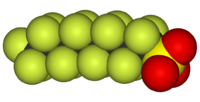
Photo from wikipedia
The ubiquity of perfluoroalkyl acids (PFAAs) contrasts with the limited information about their effects. We report here PFAA plasma concentrations in wild populations of great tits ( Parus major) settled… Click to show full abstract
The ubiquity of perfluoroalkyl acids (PFAAs) contrasts with the limited information about their effects. We report here PFAA plasma concentrations in wild populations of great tits ( Parus major) settled at and in the vicinity of a fluorochemical plant in Antwerp (Belgium). Using two generations we obtained novel results on some poorly known issues such as differences between sexes, maternal transfer of the compounds and potential associations with the oxidative status. For five out of the 11 detected PFAAs, the concentrations were the highest ever reported in birds' plasma, which confirms that Antwerp is one of the main hotspots for PFAAs pollution. Contrary to other studies conducted in birds, we found that females presented higher mean concentrations and detection frequencies for two compounds (perfluorooctanesulfonic acid (PFOS) and perfluoroundecanoic acid (PFUnDA)) than males. Maternal transfer and the dietary intake appear to be the main route of exposure for nestlings to PFOS but not to other compounds. Finally, PFAA concentrations tended to correlate positively with protein damage in adult birds while in nestlings they positively correlated with higher activity of antioxidant enzymes (glutathione peroxidase and catalase). Experimental work is needed to confirm oxidative stress as a pathway for the pernicious effects of PFAAs.
Journal Title: Environmental science & technology
Year Published: 2019
Link to full text (if available)
Share on Social Media: Sign Up to like & get
recommendations!